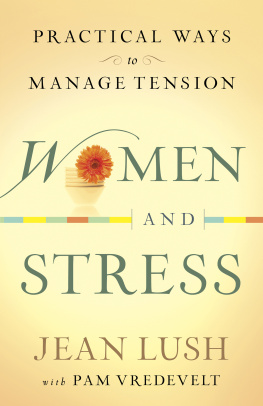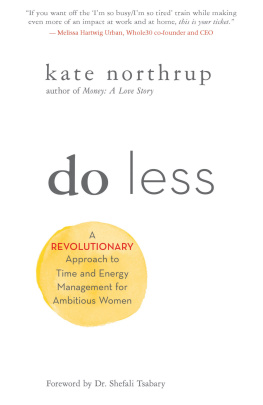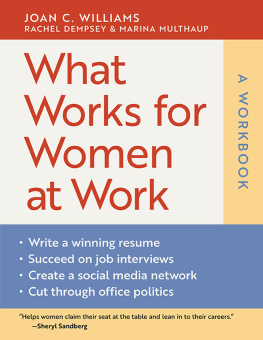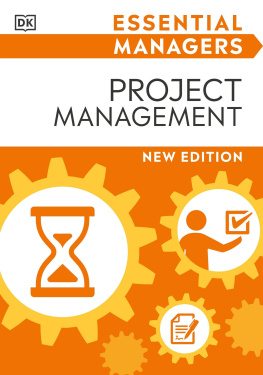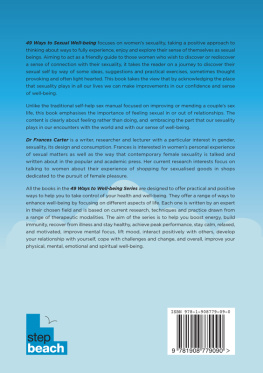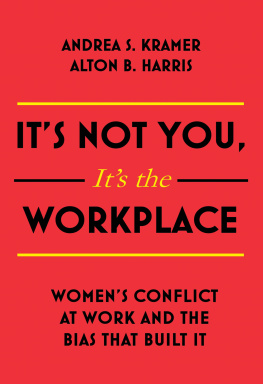To all those women managers who;
in the past, have paved the way for the rest of us;
in the present, are reaping the benefits of that pioneering
work and taking it forward;
and, in the future, will recognize the contribution of
previous generations and be able to realize for
themselves our dreams and hopes for fulfilling,
challenging and balanced lives.
And to:
All the men who are working for a world where diversity
is valued and where each individuals skills and talents
are used and appreciated.
CONTENTS
Its impossible for me to acknowledge by name many of those who have helped me with this book. They are the people Ive spoken with, listened to, lived with, fought against, been influenced by, laughed and cried with over the past fifty years. Theyve all affected the way I dealt with being a girl from a potentially disruptive background, being brought up by a remarkable mother who was determined that my brother and I should fulfil our capabilities and ambitions. Theyve all inspired me to seek out and tackle new challenges and then helped me to deal with, and learn from, the consequences, whether happy or disappointing.
Specific thanks go to the women who completed the questionnaire: Vivienne Avery, Sophie Brewer, Jan Burns, Caroline Cayzer, Janice Cook, Jill Dodwell-Groves, Margaret Elward, Judith Evans, Paula Fance, Sheila Forbes, Sally Fraser, Gay Haskins, Caroline Highwood, Sally Irvine, Wendy Kear, Pauline Kingi, Caroline Leigh, Jaki Meekings, Janice Morton, Virginia Novarra, Sharon Lee Polledri, Hilary Rowland, Marjorie Scardino, Christine Smart and Gill Sutherland. I am indebted to those who, in addition, provided material for the case studies: Theresa Barnett, Sarah Beech, Julia Budd, Carol Gladwin, Beverley Fowle, Judy Oliver, Zo Reed, Sarah Sharratt and Alison Thome. Most of the quotes used in the book are theirs which means they are really my co-authors. My thanks also go to Susan Hay who has been involved in childcare provision over the last decade and who gave me her views on how it has evolved over that period. The good-natured co-operation of all these women has made this exercise a hugely enjoyable and informative experience. I am pleased and proud to have been able to include them in this book I hope they approve of the result.
I am grateful to Elisabeth Henderson and her colleagues at the Recess College for taking the time in the middle of a busy programme to update the details of the college.
Lady Howe, chairman of Opportunity 2000, and Viki Holton at Ashridge Management were generous with their time and assistance during my research I greatly appreciated their enthusiasm, especially as they must face endless enquiries on a daily basis.
Additional thanks to all the women who worked with me on a workshop at the AMED Annual Conference in April 1997; they provided me with many of the examples and thoughts I needed to tie up loose ends in the text.
Thanks go to Lucinda McNeile and Emma Harrison-Topham of HarperCollins for having the faith to commission the book and for their unfailing patience when the computer crashed and my time management skills failed!
My husband, Bob, is always there to set an example of how rewarding it is to be generous with time and support. He, together with family, friends and colleagues, make almost anything possible!
Final and most heartfelt thanks go to my mother, Jean, who always makes me believe that I can achieve whatever I set out to do.
The role of women in the world of work, and the consequent impact it will have on corporate cultures, is at a crucial transitional point as we approach the Millennium. How organizations respond will determine to a large extent the future of business and the economic success of the nation.
The world of work is undergoing a significant transformation and is learning, through necessity, to manage that change. Organizations of all sizes are rethinking not only how they are structured but, above all, how they are run and what types of directing and managing styles are appropriate.
Growing recognition and acceptance that women bring different and unique talents to the workplace has resulted in women making remarkable headway in organizations during the latter years of this century. That awareness must now be taken a step further by fully integrating men and women within corporate cultures so that organizations may reap the benefit of the combination of both sexes abilities and qualities.
First, the statistics: all indicators point to significant changes in the future composition of the working population of the United Kingdom. Social Trends 27 the 1997 edition of the annual survey of life in the UK published by the Office for National Statistics reports that, by 2006, the number of full-time jobs is not expected to show any significant increase or decrease, but that the existing trend for more part-time and self-employed workers is likely to be reinforced.
It is anticipated that, by 2006, women will account for 46% of the entire workforce; and of the additional 1.4 million people expected in the workforce, 1 million will be women. The number of part-time workers is set to rise by 10% and those in self-employment by 25%. Traditionally, women are more likely to be in part-time work, but that trend, too, is changing. Between 1986 and 1996, the numbers of women in part-time work rose by 17% to 5.3 million, but the number of men doubled to 1.2 million. Social Trends 27 also reports that, in 1995, the UK had a higher proportion of people working from home than any other EU country, with 30% of males and 25% of females working at home for at least part of the year.
If these statistics are borne out, then the number of women within all spheres of the workplace will increase dramatically and the nature of organizations will undoubtedly change. As modern companies recognize the need to be people-oriented and family-friendly in order to move forward and succeed, they will need to build on the feminine characteristics which complement the masculine traits that have traditionally typified corporate cultures. The workplace would then not drive women away, but become much more attractive to them.
As society re-evaluates the way it conducts itself, and as businesses search for healthier ways of organizing themselves, the old ways are being called into question. Characteristics of traditional, male-dominated organizations where women have been judged by masculine yardsticks are no longer accepted as the norm. The competitive, controlling, hierarchical, dictatorial, critical approaches epitomized by the Army, the Church and the State, and practised by many business organizations, are being strongly challenged by supporters of the more intuitive feminine qualities of co-operation, facilitation, coaching and an ability to listen to and encourage other people.
Already, a great number of highly successful women have paved the way to a point where their influence is beginning to be felt and appreciated. Marjorie Scardino, Chairman of the Pearson Group, has become the first female chairman of a FT-SE 100 company. By example, such women have highlighted alternative approaches to the traditional managerial styles of the past, and are teaching organizations to react positively in their attitudes to employing women. In turn, organizations are accepting that womens capabilities provide a useful, complementary and necessary foil to the skills and qualities of their male employees. This is why there is such a strong and determined move towards establishing equality of opportunity in the workplace.
In the aftermath of the publication of GCSE and A level results in 1994, there were several articles remarking on the fact that girls schools had forged ahead in the league tables. In an article featured in


